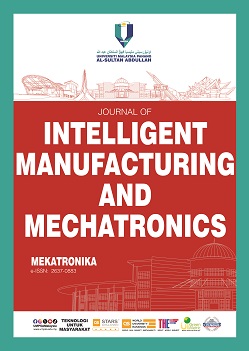Enhancing Decision-Making Based on Social Responses for Human-Robot Interactions (HRI) Applications
DOI:
https://doi.org/10.15282/mekatronika.v6i1.10163Keywords:
Decision-making, Human-Robot Interaction (HRI), Social responses, Verbal Social Cues, AcceptanceAbstract
Making decisions, especially in uncertain situations, can be challenging. This study explores how a social robot, acting as an advisor, affects human decision-making in a specially designed game. The social robot facilitated the decision-making process using verbal cues in a study with a 2x2 between-subject (controlling language and social praise) design experiment. Drawing from the Technology Acceptance Model (TAM) and the Persuasive Robots Acceptance Model (PRAM), the study assess how human responses influence the acceptance of this technology. Sixty participants took part in the experiment, and as results, their anxiety levels decreased after interacting with the robot and playing the game. Also, the outcomes highlight positive social responses, suggesting that social robots have potential in supporting decision-making even though the specific impact of social cues on participant responses is somewhat limited. In conclusion, incorporating social responses such as liking and beliefs enhances the ability to predict acceptance, emphasizing the importance of considering social aspects in the acceptance of robots. This research contributes to the understanding of Human-Robot Interactions (HRI) and provides valuable insights for future developments in social robots for decision-making support.
References
Hengen, K.M. and G.W.J.F.i.P. Alpers, Stress makes the difference: Social stress and social anxiety in decision-making under uncertainty. 2021. 12: p. 578293.
Sepasi Lalaloo, A., Robo-Advisors in Real Estate Finance: A Comprehensive Study of Borrower Preferences and Platform Performance. 2023, Politecnico di Torino.
Reeves, B. and C.J.C. Nass, UK, The media equation: How people treat computers, television, and new media like real people. 1996. 10(10).
Satti, Z.W., M.O.J.P.J.o.H. Khan, and S. Sciences, Examining the Mediating Impact of Attitude Towards Mobile App Use on the Relationship between TAM Factors and Consumers' Purchase Intentions. 2023. 11(2): p. 1322–1336-1322–1336.
Fatokun, B.O., Customers’ Affective Responses Towards the Key Factors Influencing E-Commerce Adoption: Extended Technology Acceptance Model (TAM) Approach. 2023, Liverpool john Moores University, UK.
Ethugala Pathiranage, G., et al. User Acceptance of Social Robots: A Social Response Perspective. in Proceedings of the 30th European Conference on Information Systems (ECIS 2022). 2022. Association for Information Systems.
Davis, F.D.J.M.q., Perceived usefulness, perceived ease of use, and user acceptance of information technology. 1989: p. 319-340.
Lateef, M. and P.J.J.o.t.K.E. Keikhosrokiani, Predicting Critical success factors of business intelligence implementation for improving SMEs’ performances: a case study of Lagos State, Nigeria. 2022: p. 1-26.
Zhao, J., J.J.I.j.o.e.r. Wang, and p. health, Health advertising on short-video social media: A study on user attitudes based on the extended technology acceptance model. 2020. 17(5): p. 1501.
Hair Jr, J., et al., A primer on partial least squares structural equation modeling (PLS-SEM). 2021: Sage publications.
Ghazali, A.S., et al., Persuasive robots acceptance model (PRAM): roles of social responses within the acceptance model of persuasive robots. 2020. 12: p. 1075-1092.
Boos, A., et al., A compliance–reactance framework for evaluating human-robot interaction. 2022. 9: p. 733504.
Wang, B. and P.-L.P.J.I.J.o.S.R. Rau, Influence of embodiment and substrate of social robots on users’ decision-making and attitude. 2019. 11: p. 411-421.
Onyeulo, E.B. and V.J.I. Gandhi, What makes a social robot good at interacting with humans? 2020. 11(1): p. 43.
Zörner, S., et al., An immersive investment game to study human-robot trust. 2021. 8: p. 644529.
Smiderle, R., et al., The impact of gamification on students’ learning, engagement and behavior based on their personality traits. 2020. 7(1): p. 1-11.
Flogie, A., et al., Development and evaluation of intelligent serious games for children with learning difficulties: observational study. 2020. 8(2): p. e13190.
Spielberger, C.D., et al., Measuring anxiety and anger with the State-Trait Anxiety Inventory (STAI) and the State-Trait Anger Expression Inventory (STAXI). 1999: Lawrence Erlbaum Associates Publishers.
Brehm, S.S. and J.W. Brehm, Psychological reactance: A theory of freedom and control. 2013: Academic Press.
Van der Heijden, H.J.M.q., User acceptance of hedonic information systems. 2004: p. 695-704.
Chauhan, S.J.i., Acceptance of mobile money by poor citizens of India: Integrating trust into the technology acceptance model. 2015. 17(3): p. 58-68.
Chen, T.L., et al., Older adults’ acceptance of a robot for partner dance-based exercise. 2017. 12(10): p. e0182736.
Verberne, F.M., et al. Trusting digital chameleons: The effect of mimicry by a virtual social agent on user trust. in Persuasive Technology: 8th International Conference, PERSUASIVE 2013, Sydney, NSW, Australia, April 3-5, 2013. Proceedings 8. 2013. Springer.
Guadagno, R.E., et al., Social influence online: The impact of social validation and likability on compliance. 2013. 2(1): p. 51.
Venkatesh, V. and F.D.J.M.s. Davis, A theoretical extension of the technology acceptance model: Four longitudinal field studies. 2000. 46(2): p. 186-204.
Jian Wang, Y., et al., Superstitious beliefs in consumer evaluation of brand logos: Implications for corporate branding strategy. 2012. 46(5): p. 712-732.
Heerink, M. Exploring the influence of age, gender, education and computer experience on robot acceptance by older adults. in Proceedings of the 6th international conference on Human-robot interaction. 2011.
Tay, C., S. Ang, and L.J.J.o.A.P. Van Dyne, Personality, biographical characteristics, and job interview success: a longitudinal study of the mediating effects of interviewing self-efficacy and the moderating effects of internal locus of causality. 2006. 91(2): p. 446.
Dillard, J.P. and L.J.C.m. Shen, On the nature of reactance and its role in persuasive health communication. 2005. 72(2): p. 144-168.
Dillard, J.P. and E.J.C.r. Peck, Affect and persuasion: Emotional responses to public service announcements. 2000. 27(4): p. 461-495.
Kaptein, M., et al., Two acts of social intelligence: the effects of mimicry and social praise on the evaluation of an artificial agent. 2011. 26: p. 261-273.
Ringle, C.M., S. Wende, and J.-M. Becker. SmartPLS 3 [computer software]. 2015; Available from: https://www.smartpls.com.
Ozili, P.K., The acceptable R-square in empirical modelling for social science research, in Social research methodology and publishing results: A guide to non-native english speakers. 2023, IGI Global. p. 134-143.
Martens, R., and Hildebrand, C.J.B. Dementia care, robot pets, and aliefs’, 2021, 35, (9), pp. 870-876
Laban, G., Kappas, A., Morrison, V., and Cross, E.S.J.I.J.o.S.R. Building Long-Term Human–Robot Relationships:Examining Disclosure, Perception and Well-Being Across Time, 2023
Downloads
Published
Issue
Section
License
Copyright (c) 2024 The Author(s)

This work is licensed under a Creative Commons Attribution-NonCommercial 4.0 International License.




